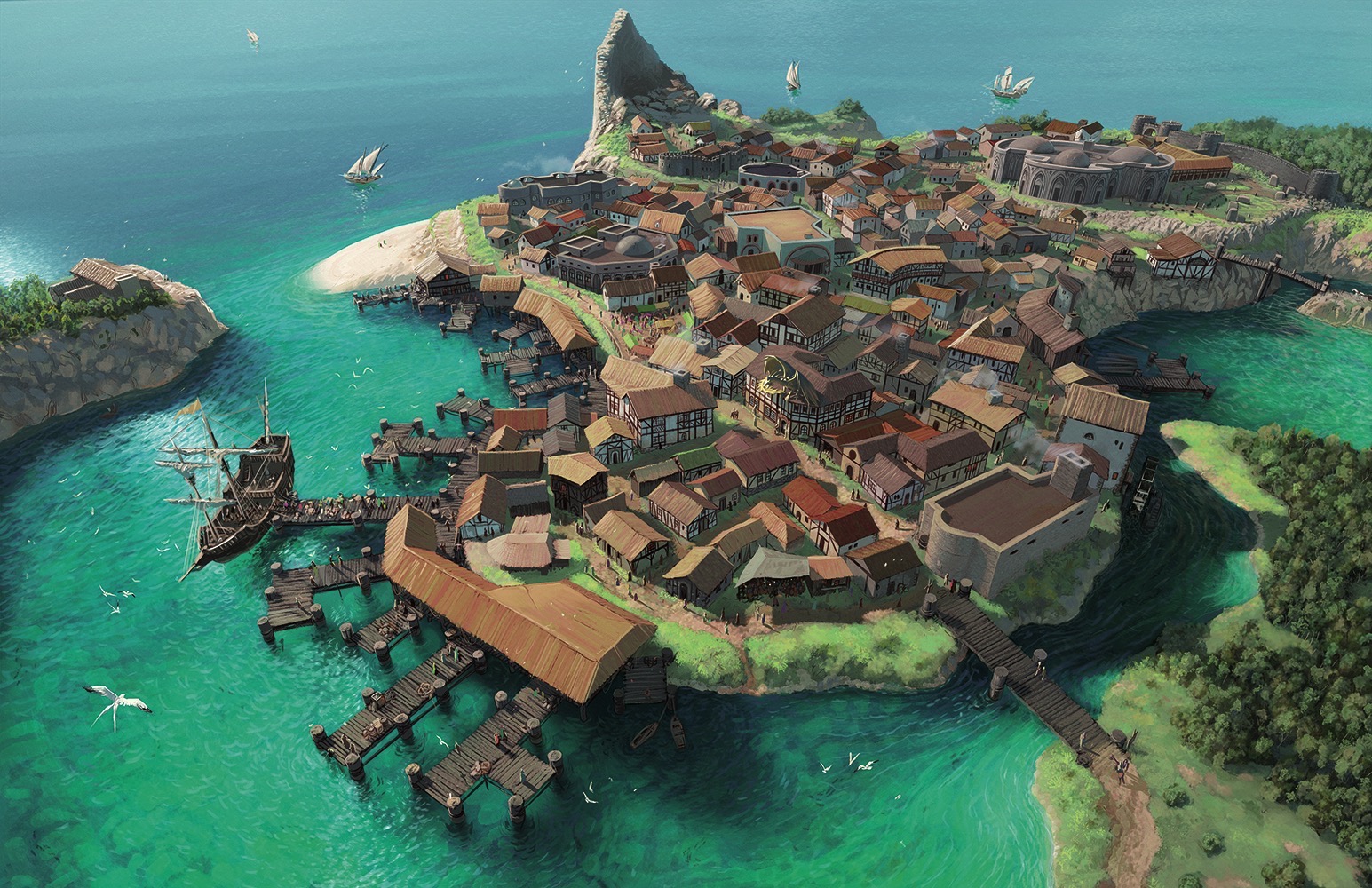Sandpoint
Sandpoint Lore - Locals Knowledge
Sandpoint History - Locals knowledge
Scattered pockets of civilization dot the Lost Coast. Traditional Varisian camps can be found in nearly every gulch and hollow along the rugged, cliff-lined shores, while solitary houses perch on bluffs—homes to eccentrics or wealthy individuals seeking solitude far from Magnimar’s bustling streets. Inns appear along the Lost Coast Road every 24 miles, positioned to match the distance most travelers can cover in a day. Low stone shrines dedicated to Desna, goddess of wanderers and patron of the Varisians, offer additional shelter, a welcome refuge during the region’s frequent rainstorms.
Given time, any of these outposts of civilization could grow into a thriving town—or even a city. This has already happened once, along a natural harbor nestled in the cliffs some fifty miles northeast of Magnimar. What was once a larger-than-usual Varisian camp beneath the shadow of an ancient ruined tower has since transformed into the Lost Coast’s largest settlement: Sandpoint, the Light of the Lost Coast.
As one nears Sandpoint, signs of civilization become more apparent. Farms grow more numerous across the moors and river valleys, and the blue-green waters of the Varisian Gulf teem with fishing vessels. Wooden bridges increasingly replace fords over streams and rivers, and the Lost Coast Road itself widens and becomes better maintained. The town remains hidden from view until the final approach—concealed by the imposing limestone formations known as the Devil’s Platter and a scattering of rocky outcrops and forested hills to the east. But as the last bend in the road is rounded, Sandpoint reveals itself, its smoking chimneys and bustling streets offering weary travelers the promise of warm beds and a welcome respite from the lonely road.
Approaching from the south, travelers enter Sandpoint via a wooden bridge, while from the north, a low stone wall provides a measure of protection. Here, the Lost Coast Road passes through a stone gatehouse, usually manned by one or two guards; in contrast, the southern bridge is often left unguarded. Aside from the occasional Goblin, Sandpoint’s residents have little to fear from invasion or banditry—the region simply isn’t populated enough for such dangers to be profitable.
At both the gatehouse and the southern bridge, a sign hangs from a bent nail beside a mirror. Painted upon it is a simple yet welcoming message:
"Welcome to Sandpoint! Please stop to see yourself as we see you!"
Given time, any of these outposts of civilization could grow into a thriving town—or even a city. This has already happened once, along a natural harbor nestled in the cliffs some fifty miles northeast of Magnimar. What was once a larger-than-usual Varisian camp beneath the shadow of an ancient ruined tower has since transformed into the Lost Coast’s largest settlement: Sandpoint, the Light of the Lost Coast.
As one nears Sandpoint, signs of civilization become more apparent. Farms grow more numerous across the moors and river valleys, and the blue-green waters of the Varisian Gulf teem with fishing vessels. Wooden bridges increasingly replace fords over streams and rivers, and the Lost Coast Road itself widens and becomes better maintained. The town remains hidden from view until the final approach—concealed by the imposing limestone formations known as the Devil’s Platter and a scattering of rocky outcrops and forested hills to the east. But as the last bend in the road is rounded, Sandpoint reveals itself, its smoking chimneys and bustling streets offering weary travelers the promise of warm beds and a welcome respite from the lonely road.
Approaching from the south, travelers enter Sandpoint via a wooden bridge, while from the north, a low stone wall provides a measure of protection. Here, the Lost Coast Road passes through a stone gatehouse, usually manned by one or two guards; in contrast, the southern bridge is often left unguarded. Aside from the occasional Goblin, Sandpoint’s residents have little to fear from invasion or banditry—the region simply isn’t populated enough for such dangers to be profitable.
At both the gatehouse and the southern bridge, a sign hangs from a bent nail beside a mirror. Painted upon it is a simple yet welcoming message:
"Welcome to Sandpoint! Please stop to see yourself as we see you!"
Forty-one years ago, settlers from the southern nation of Cheliax arrived in Varisia. The city of Magnimar was founded by colonists dissatisfied with the reliance on Chelish influence in eastern Varisia, and before long, the need for additional farmland became apparent. To the south, the sprawling Mushfens made agriculture nearly impossible, so settlers turned their eyes north along the Lost Coast. For much of its length, the coastline offered little in the way of shelter—except for one perfect cove, about fifty miles from Magnimar. Overlooking this cove stood an ancient and enigmatic stone ruin.
Establishing a new town was no small endeavor, nor one that could be financed by a single benefactor. Four influential Magnimarian families—rather than compete—joined forces to form the Sandpoint Mercantile League. These families—the Kaijitsus (glassmakers), Valdemars (shipbuilders), Scarnettis (loggers), and Deverins (farmers and brewers)—secured land rights and set sail northward to claim their stake. However, upon arriving in the spring of 4666 AR, they found that a large Varisian tribe already called the area home.
Undeterred, the Sandpoint Mercantile League initiated negotiations, offering the Varisians an important role in the new settlement. Yet after a week of fruitless discussions, impatience got the better of one man—Alamon Scarnetti. Taking matters into his own hands, he and a band of his brothers and cousins launched a brutal raid on the Varisian camp, hoping to slaughter the inhabitants and frame the local Goblins for the attack. However, their drunken overconfidence proved disastrous. They managed to kill only five Varisians before being forced to flee, leaving behind three of their own dead.
The League quickly retreated to Magnimar, where they were soon embroiled in the consequences of Alamon’s reckless assault. The city’s Varisian Council demanded severe punishment for all four families. Yet through a combination of diplomacy and pragmatism, a resolution was brokered—largely thanks to Almah Deverin, a gifted young bard and member of one of the accused families. She not only defused the Varisians’ calls for blood payment but also salvaged Sandpoint’s future by negotiating a lasting agreement. As part of the settlement, the League promised to incorporate the worship of Desna into the town’s new cathedral and pledged a generous share of Sandpoint’s profits to the Varisian Council for the next forty years.
One year later, with the full cooperation of the Varisian people, construction began. In the decades since its founding, Sandpoint has flourished. The initial term of the agreement with the Varisian Council has expired, yet the town’s leaders have chosen to extend it for another twenty years—a decision not without controversy among some locals.
Throughout its history, Sandpoint has been fortunate to avoid major calamities. Harsh winter storms are common, yet the natural harbor, sandbars, and cliffs help blunt the worst of the wind and waves. While elders tell tales of a few truly fierce tempests, the town has endured only two real disasters—the Chopper murders and the Sandpoint Fire. Occurring in close succession, these tragedies have become collectively known as "The Late Unpleasantness"—though no clear link between them was ever found.
To this day, Sandpoint’s residents prefer not to dwell on those dark times, choosing instead to look ahead—to brighter days and a promising future.
Founding Date
4666
Alternative Name(s)
Light of the Lost Coast
Type
Town
Population
1,240
Location under
Included Locations
Owner/Ruler
Owning Organization
Characters in Location
Related Reports (Primary)






Comments